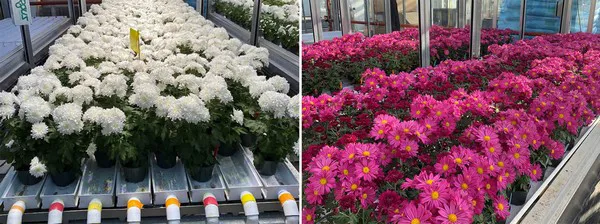The ever-increasing cost of fertilizer inputs is just one reason why growers of agricultural and horticultural crops in both outdoor and controlled greenhouse growing environments have found it necessary to take a closer look at their application rates and practices. Across Canada, the horticultural sector and especially greenhouse growers have come under additional scrutiny as the possible source of contamination when unacceptable levels of pollutants have been found in nearby streams and ponds. Just as critical, therefore, has been the need to meet increasingly stringent regulations set by environmental agencies to control the quality of irrigation run-off water.

As a result, researchers are now looking to answer the seemingly simple question of “how low can you go,” as part of the solution to both dilemmas which currently face the floriculture greenhouse grower.
 A research project currently underway by the University of Guelph’s Dr. Barry Shelp, “Optimizing nutrient delivery in greenhouse-grown potted chrysanthemums: Sub-irrigation and drip irrigation systems” tests the hypothesis that nutrient use can be vastly improved by strategically manipulating the timing of nutrient delivery to the plant. This project is part of the “Accelerating Green Plant Innovation for Environmental and Economic Benefit” Cluster and is funded by the Canadian Ornamental Horticultural Alliance (COHA-ACHO), private sector companies, and the Government of Canada under the Canadian Agricultural Partnership’s AgriScience Program, a federal, provincial, territorial initiative Dr. Shelp’s current project is specifically focused on testing the improved delivery of micro-nutrients to both drip irrigated and sub-irrigated chrysanthemums.
A research project currently underway by the University of Guelph’s Dr. Barry Shelp, “Optimizing nutrient delivery in greenhouse-grown potted chrysanthemums: Sub-irrigation and drip irrigation systems” tests the hypothesis that nutrient use can be vastly improved by strategically manipulating the timing of nutrient delivery to the plant. This project is part of the “Accelerating Green Plant Innovation for Environmental and Economic Benefit” Cluster and is funded by the Canadian Ornamental Horticultural Alliance (COHA-ACHO), private sector companies, and the Government of Canada under the Canadian Agricultural Partnership’s AgriScience Program, a federal, provincial, territorial initiative Dr. Shelp’s current project is specifically focused on testing the improved delivery of micro-nutrients to both drip irrigated and sub-irrigated chrysanthemums.

Commercial trials with different N (left) and NPK (right) rates.
The current project is a continuation of his previous research project under the Growing Forward 2 (2013 – 2018) Cluster program which demonstrated the successful reduction of macronutrient use. In that project, Dr. Shelp was able to verify that the supply of nitrogen, phosphorous, sulfur and potassium could be reduced by as much as 75 to 87.5% compared to current industry standards, without any adverse impacts to crop yield or quality.
The overall premise of his current research, says Dr. Shelp, to test the limits of lowering fertilizer inputs seems very simple. However, far more complex is the understanding of plant physiology and using a plant’s inherent capacity and attributes to inform the decision-making processes about fertilizer application which has shaped the foundation of his hypothesis.
“For many years, and even as a post-doc, I began to understand and marvel at plant characteristics associated with nutrient acquisition and redistribution in the plant. I came to realize that a plant’s source of nutrition changes as the plant grows and develops and if proven to be true, that premise could greatly influence commercial fertilization practices. Although that was many years ago, I am grateful for the circumstances that are finally giving me the opportunity to test my theory.”
Articulating his hypothesis in simple terms, Dr. Shelp explains that young plants absorb nutrients through the root system, but that changes as the plant matures. Plants then start to use previously acquired and stored nutrients and use them for fruit and flower development. By strategically lowering the nutrition rates, plants can be induced to better absorb nutrients early in the growth cycle and to redistribute their stored resources later in the growth cycle to supply the reproductive parts of the plant.
Rather than continuously supplying a plant with nutrients, Dr. Shelp’s theory calls for an interruption to fertilizer application at a time in a plant’s growth cycle when it has sufficient stored nutrients in the leaves to sustain reproductive growth. Typically, the time is best at the onset of flowering, when the plant transitions from vegetative to reproductive growth, is most efficient at mobilizing nutrients, and the uptake of nutrients through the root system starts to decline. Remarkably, this procedure can be combined with a reduction in nutrient supply to the young plants, and as long as it not excessive, the efficiency of nutrient uptake by the roots is improved so that the plant acquires and stores the same amount of nutrients as with a much higher nutrient supply.
 Research trials with different Fe (left) and Zn (right) rates.
Research trials with different Fe (left) and Zn (right) rates.
Dr. Shelp recognizes the challenges associated with grower adoption of new technologies and growing practices. “Once growers have a formula that works for them, it is understandable that change poses a huge risk.” He is nonetheless confident that it is only a matter of time before growers slowly implement the new and reduced fertilization guidelines based on his research results.
It is a very simple matter to quantify the savings that can be realized through less fertilizer use. It is more difficult to quantify the savings that can be achieved through reduced costs associated with cleansing spent irrigation water, and especially the run-off that occurs with drip irrigation. “It’s difficult to put a value on being able to meet the strict regulations set by environmental agencies, but growers instinctively recognize the benefits are significant.”
Conducted at both the University of Guelph’s experimental greenhouse labs and a Niagara-based commercial greenhouse grower, Dr. Shelp’s research focused on chrysanthemums, using four commonly grown varieties, as they are the largest dollar volume greenhouse floriculture crop grown in Canada. Crops were measured for yield and overall plant quality and nutrient leaf analysis by the University’s Laboratory Services division was used to provide information on the level of micronutrients. To date, Dr. Shelp has worked with sub-irrigation systems because if managed properly, the composition of the excess nutrient solution is essentially unchanged, so it can be recycled and reused. However, he intends to also test his modified delivery strategy with drip irrigation because of its importance in the industry. If the nutrient supply can be reduced, then it should be possible to reduce the overirrigation that is required to prevent salt accumulation in the growing medium, thereby conserving both nutrients and water.
After research validating his theory on the reduced use of macronutrients (nitrogen, phosphorous, potassium, calcium, magnesium and sulfur), Dr. Shelp set out to study the impacts of reducing the use of micronutrients. In separate trials, the project looked at zinc, copper, iron, manganese, boron and molybdenum. Depending on the formulation of the comparative commercial formulas being studied, results showed that delivery of these nutrients can be reduced by 85-95% over the crop cycle without sacrificing plant and flower quality.
The significance of the research results, says Dr. Shelp, point to several logical “next-step” applications, including outdoor production of ornamental floriculture crops and possibly controlled environment production of edible crops.
For supporting graphics & more information, please visit the website of COHA.
